

AALAS General Standards - Academy of Active Learning Arts and Sciences. The General Standards are a Flipped Learning roadmap to help educators reach every student in every class every day.
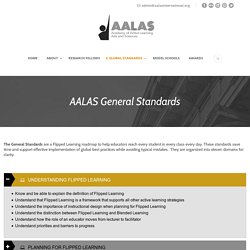
These standards save time and support effective implementation of global best practices while avoiding typical mistakes. They are organized into eleven domains for clarity. Know and be able to explain the definition of Flipped LearningUnderstand that Flipped Learning is a framework that supports all other active learning strategiesUnderstand the importance of instructional design when planning for Flipped LearningUnderstand the distinction between Flipped Learning and Blended LearningUnderstand how the role of an educator moves from lecturer to facilitatorUnderstand priorities and barriers to progress Collect data on the efficacy of your Flipped classConduct action research on your class and share with the global communityStay abreast of the latest research on Flipped LearningBuild bridges between researchers and practitioners.
Moodle. Course Workload Estimator — Rice University Center for Teaching Excellence. Aaronson, Doris, and Steven Ferres.
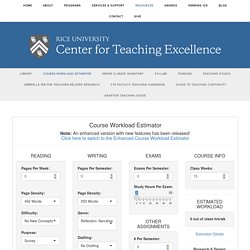
“Lexical Categories and Reading Tasks.” Journal of Experimental Psychology: Human Perception and Performance 9, no. 5 (1983): 675–99. doi:10.1037/0096-1523.9.5.675. Acheson, Daniel J., Justine B. Remote Learning Resources and Strategies. Emergency School Closures - Eduro Learning.
How to choose the best Ed-Tech tools for Online Instruction. How many ‘ed-tech’ tools are out there that can enhance online learning?
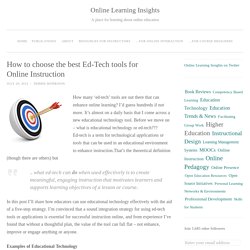
I’d guess hundreds if not more. It’s almost on a daily basis that I come across a new educational technology tool. Before we move on – what is educational technology or ed-tech??? Ed-tech is a term for technological applications or tools that can be used in an educational environment to enhance instruction.That’s the theoretical definition (though there are others) but .. what ed-tech can do when used effectively is to create meaningful, engaging instruction that motivates learners and supports learning objectives of a lesson or course. In this post I’ll share how educators can use educational technology effectively with the aid of a five-step strategy. How to teach online. This is the first article in a three-part series featuring strategies and skill development for instructors wanting to create, facilitate and encourage collaboration among students working in groups.
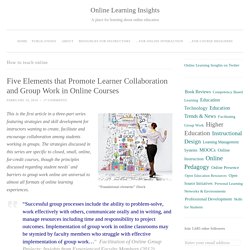
The strategies discussed in this series are specific to closed, small, online, for-credit courses, though the principles discussed regarding student needs’ and barriers to group work online are universal to almost all formats of online learning experiences. “Successful group processes include the ability to problem-solve, work effectively with others, communicate orally and in writing, and manage resources including time and responsibility to project outcomes. Implementation of group work in online classrooms may be stymied by faculty members who struggle with effective implementation of group work…” Facilitation of Online Group Projects: Insights from Experienced Faculty Members (2012) Why Group Work? 1. 2. 3. 4. K-12 Blended And Online Learning. See All K 12 Blended And Online Learning Articles Strategic Planning in e-Learning By Alison Carr-Chellman / May 17, 2016 As most in leadership know well, online learning, e-learning and other forms of distributed learning are increasingly important as parts of strategic plans for organizations, higher education, and k-12 schools.

This article briefly takes up a few of the critical elements of strong strategic plans including the uses and importance of needs assessment, reflection, identifying organizational e-learning strengths, opportunities, and resources, seeing novel and unique program opportunities, and the importance of a core group of supporters for the programs forwarded in the strategic plan. » [Full Article] TYPE: OPINION, CORPORATE LEARNING, HIGHER EDUCATION, K-12 BLENDED AND ONLINE LEARNING Building a Blended Learning Classroom that Works.
Implications Of Learning Theories On Instructional Design. Let's look closer at each learning theory, one at a time, explaining not only their definitions but also their implication on ID today.
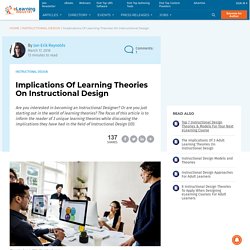
Behaviorist Learning Theory 1. Definition Behavioral learning theory can be summarized as learning that occurs through the behavioral response to environmentally sourced stimuli [1]. The foundation of this theory is built upon assumptions that "have little regard for the cognitive processing of the learner involved in the task" [2].
Τhe instructional task is the focus of a behavior response,Τhe learning occurs through the influence of environmental stimuli, andΤhe learning occurs through the process of repetition or rehearsal of the behavior. 12 Different Types of Blended Learning (Top Models) - TeachThought. By TeachThought Staff Blended Learning is not so much an innovation as it is a natural by-product of the digital domain creeping into physical spaces.
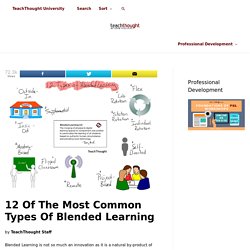
Course Design Archives - TeachOnline. By Andrew Salcido and Jessica Cole One of the most common questions an Instructional Designer is faced with is, “How can I enhance the student experience in my online course?”
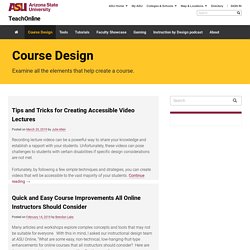
Often times, instructors wish to replicate the activities they do in face-to-face courses in the online environment but are not sure where to begin. One recommendation is to consult an instructional designer. Interactive Storytelling: Opportunities for Online Course Design. 276,512 free vector icons. Georgia Southern University. 8 Ways to Design Sticky MOOCs. This is a guest post from Donald Clark.

It was originally published here. Increasing persistence Many of the arguments around course completion in MOOCs are, I have argued, category mistakes. Those mistakes are based on a false comparison with traditional higher education, semester-long, courses. We should not, of course, allow these arguments to distract us from making MOOCs better, in the sense of having more sticking power for participants. 1. MOOC learners are not undergraduates who expect a diet of lectures delivered synchronously over a semester. 2. To be sensitive to a variety of learners (see why course completion is a wrong-headed measure), the solution is to provide flexible approaches to learning within a MOOC, so that different learners can take different routes and approaches. 3. Learners’ Interpersonal Beliefs and Generated Feedback in an Online Role-Playing Peer- Feedback Activity: An Exploratory Study. Volume 17, Number 2.
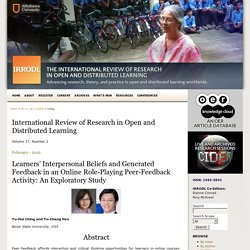
Visual Thinking In eLearning: What eLearning Professionals Should Know. How can eLearning professionals create eLearning courses that appeal to our visual nature while still including all of the key subject matter? In this article, I’ll explore the basics, benefits, and uses of visual thinking in eLearning. Visual thinking refers to a learning approach that links complex ideas or concepts to visual elements, such as images, word maps, or infographics. Visual thinking can be used by eLearning professionals to create meaningful eLearning content, as well as by online learners to visually represent their ideas and thoughts during the eLearning process.
Top 3 Visual Thinking Benefits In eLearning Simplifies complex concepts. Top 5 Tips To Use Visual Thinking In eLearning Include infographics that convey core ideas. Well written eLearning content is essential, but you have the power to transform your eLearning course into an interactive and memorable experience by taking a visual thinking approach. A Peek Inside Summit’s Personalized Learning Software. Over the last three years, Summit Public Schools, a network of charter public high schools in northern California, has made a radical shift from a traditional high school model to an innovative, competency-based learning model. In this new model, students are responsible for independently mastering basic content, freeing up teachers to spend class time on projects and other tasks that promote deeper learning. Summit’s push to reimagine its programs was based on four core ideas: To succeed in college and in life, students must be self-directed learners. In addition to basic content knowledge, students need to develop high-level cognitive skills like Inquiry, Listening and Analysis.
Student should have personalized learning paths so they can learn content at their own pace and in ways that work best for them. These ideas are no longer aspirational. In this article, we will do a guided tour of the PLP software to describe the student experience and explain how the school model works. Open Online Education.
A step-by-step guide for making online classes accessible. Montana State University professors discuss a 10-step plan to applying Universal Design for Learning in online courses. According to professors at Montana State University (MSU), incorporating Universal Design for Learning (UDL) in online courses not only benefits students with disabilities, but can have significant benefits for all students, ultimately increasing retention and improving learning outcomes—but how to implement? The implementation guidelines are part of a recent report written by Dr. Cindy Ann Dell, assistant professor, Educational Theory and Practice at MSU; Thomas Dell, assistant professor, Rehabilitation and Human Services at MSU; and Dr.
PBL & Tech ISTE 2015. JOLT - Journal of Online Learning and Teaching. Getting Online - Introduction. eLearn Magazine. Revisiting Multiliteracies in Collaborative Learning Environments: Impact on Teacher Professional Development. September 2006 — Volume 10, Number 2 * On the Internet * By Vance Stevens Petroleum Institute, Abu Dhabi, UAE Editor’s foreword: At this time last year I wrote an article for the On the Internet column, “Multiliteracies for Collaborative Learning Environments”. (Stevens 2005; As indicated in the editor’s note at the foot of that article, it was prepared partly as a rough guide for the participants in my TESOL, Inc. Certificate Program course of the same name [ which completes its third rendition this October. This article derives from a presentation given virtually via recorded video at the 12th International CALL Research Conference How are we doing?
Basic concepts This article revisits applying multiliteracies in collaborative learning environments, and particularly the impact of this on teacher professional development. My course on multiliteracies is run from Venny Su’s OpenSource for Educators server (see Su, 2005). Web 2.0 vs. What is Web 2.0 exactly? National College: External resource. Face-to-face or Online? November 14, 2011 by Brian Chanen · 1 Comment · Brian Chanen, Online/Blended Learning, Others When, like Jason, I think of the most meaningful educational experiences I have had, I remember a number of moments from working through a difficult novel to the time I finally realized that if you throw a Rubik’s cube really hard against a wall it will break into colorful mini-cubes.
If I’m serious about trying to envision important moments of learning, though, I also tend to remember people—the teachers who helped me or the friends who took classes with me. I often consider myself lucky to be at a school that is small enough for teachers and students to work closely together and dedicated enough to invest heavily in a face-to-face, brick-and-mortar expansion into a new building. Everyone here at ASB is excited to create an innovative space where students, teachers, and community members can interact and learn. Facilitating learning and change in groups and group sessions. Facilitating learning and change in groups and group sessions. Just what is facilitation, and what does it involve? We explore the theory and practice of facilitation, and some key issues around facilitating group sessions. Contents: introduction · what is group facilitation? · core conditions and the facilitator · the facilitator’s role · core values · facilitating sessions – having a plan · facilitating sessions – thinking of beginnings, middles and ends · facilitating – responding to the moment · dealing with difficult behaviour · conclusion · further reading and references · acknowledgements · how to cite this piece.